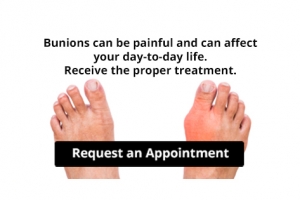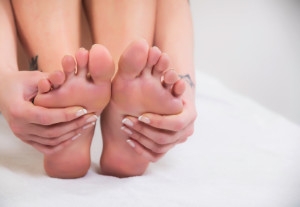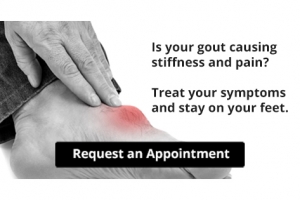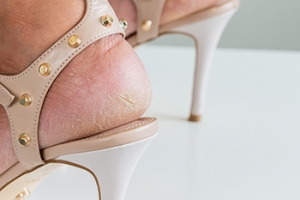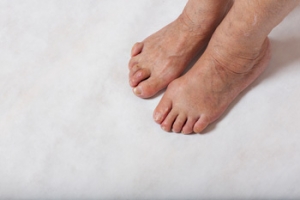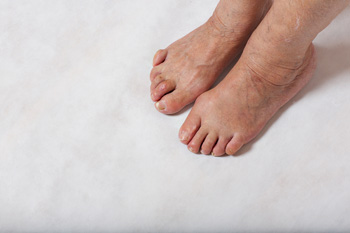Super User
Every Day Foot Care
Our feet are important in our everyday lives. The problem is that we tend to neglect them. When this becomes a habit, it can cause significant trouble. Ignoring foot problems can mean pain and limited mobility. On the other hand, if feet are cared for and looked after regularly, they will perform without pain or complication.
Routine hygiene is the most basic way to care for the feet. Wash and dry them thoroughly daily. Remember to get between the toes and keep the toenails trimmed and short. If the feet feel dry or there are signs of dryness or cracking, use a moisturizer designed for the feet.
When using moisturizer on the feet, try to avoid applying between the toes. If cream or lotion sits too long, they can cause fungal and bacterial growth. When moisturizer is used between the toes, it can also cause the skin to soften too much.
Shoes are also an important aspect of foot care. When one is picking out shoes, make sure they are the correct size. Shoes need to be snug, but not too tight. On the other hand, if shoes are too loose they can cause foot problems as well. It is highly recommended that shopping for new shoes be done later in the day. The reason for this is that the feet will have settled and swelled to their full size by then. To keep your feet at their most healthy, avoid wearing high heels or flip flops too often. Instead, choose shoes that are good for your feet. Good shoes pad the soles of your feet and support the arches and ankles.
Socks should also be worn daily with closed-toe shoes. They may feel hot during the summer months, but they absorb sweat and moisture off the feet. Without socks, the build-up of sweat in a closed-toe shoe can cause fungal problems and athlete's foot.
The best thing to remember in every day foot care is that shoes do make a difference. If you spend a lot of time on your feet, make sure that your shoes show no signs of wear. Shoes should offer ample support for the arches and the overall foot. Additionally, try to make foot cleaning and maintenance a daily habit. If you keep these things in mind, your feet will stay healthy and safe.
Are Bunions Affecting Your Everyday Life?
Preparing to Run
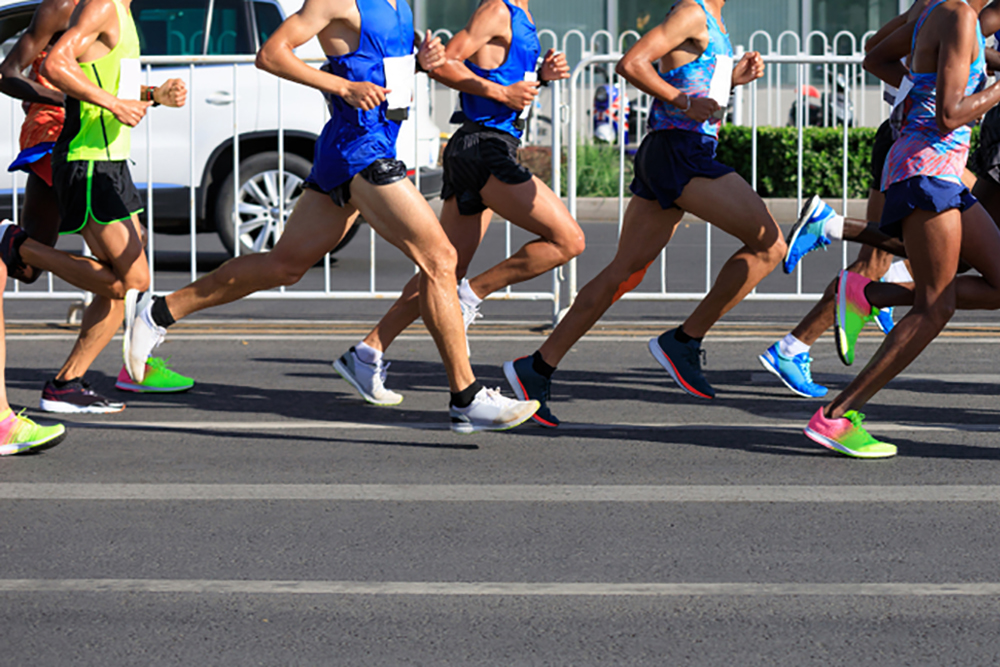 Running is a great sport to get into for your overall physical fitness, but it can be tough on the feet and ankles if you don’t first take measures to prevent injuries. If you are new to running, or resuming running after a long break, you may be able to reduce the risk of injury by stretching for a week prior to beginning to run. This will help loosen stiff joints and tissues. You should also incorporate stretching into your warm-up before each run. Wear running shoes that fit properly and offer adequate support, and replace them when they become worn out. If you do find that you have experienced an injury, stop running and consult with a chiropodist who can diagnose your condition, offer the right treatments, and help get you back on your feet.
Running is a great sport to get into for your overall physical fitness, but it can be tough on the feet and ankles if you don’t first take measures to prevent injuries. If you are new to running, or resuming running after a long break, you may be able to reduce the risk of injury by stretching for a week prior to beginning to run. This will help loosen stiff joints and tissues. You should also incorporate stretching into your warm-up before each run. Wear running shoes that fit properly and offer adequate support, and replace them when they become worn out. If you do find that you have experienced an injury, stop running and consult with a chiropodist who can diagnose your condition, offer the right treatments, and help get you back on your feet.
Exercising your feet regularly with the proper foot wear is a great way to prevent injuries. If you have any concerns about your feet, contact one of our chiropodists from The Footcare Centre. Our chiropodists will treat your foot and ankle needs.
How to Prevent Running Injuries
Many common running injuries are caused by overuse and overtraining. When the back of the kneecap starts wearing out and starts causing pain in your knee, this is commonly referred to as runner’s knee. Runner’s knee is a decrease in strength in your quadriceps and can occur if you’re not wearing properly fitted or supporting shoes. To prevent runner’s knee, focusing on hip strengthening is a good idea, as well as strengthening your quads to keep the kneecaps aligned.
What Are Some Causes of Running Injuries?
- One cause of a common running injury is called iliotibial band syndrome.
- Plantar fasciitis is also another common injury.
- Stress fractures can occur from overtraining, lack of calcium, or even your running style.
Best Ways to Prevent Running Injuries
- Wear footwear that fits properly and suits your running needs.
- Running shoes are the only protective gear that runners have to safeguard them from injury.
- Make a training schedule. Adding strengthening exercises as well as regular stretching can help keep you strong and limber and can lessen the possibility of injuries.
- Stretching keeps muscles limber; this will help you gain better flexibility.
If you have any questions please feel free to contact our office located in Niagara Falls, ON . We offer the newest diagnostic and treatment technologies for all your foot and ankle needs.
Preventing Running Injuries
Over half of all runners encounter at least one injury per year. The reason for this is because many runners do not train properly. Injuries are almost inevitable due to the physical stress that running causes. While our bodies are great at adapting to the stress, it can only handle it in small doses. Injuries occur when the stress is applied too quickly for the body to handle, causing something within it to break down. With each step you take, your leg is absorbing two or three times your body’s weight.
Some of the most popular running injuries are shin splints, plantar fasciitis, Achilles tendinitis, and stress fractures. Shin splints cause pain along the inside or outside of the shins, and this pain is usually felt at the beginning of a run. The condition itself is defined as an inflammation of the muscles or tendons located around the shinbone. To treat shin splints, it is advised that you ice the shin area and stretch the calf muscles. To prevent this injury, you should slowly increase the distance you plan on running, instead of jumping into a more strenuous routine.
Achilles tendinitis is another common injury and it feels like pain along the back of the leg, toward the heel. This condition is defined as an inflammation of the Achilles which is the largest tendon in the body. The Achilles is responsible for connecting your calf muscles to the heel bone and it is caused by tight calf muscles. If you want to treat this injury, you should take a break from running to cross train with a low-impact activity.
There are a lot of common mistakes runners make that are causing them to experience injury. One mistake is stretching too much prior to warming up. If you plan to go on a run, you should warm up with a gentle 3-5-minute walk followed by a 5-minute run-walk. Another common mistake is jumping into a routine too quickly. Consequently, you should incorporate cross-training into your routine. If you are looking to get active, you should slowly weave running into an activity you are currently participating in. For example, you can try bike riding for 40 minutes followed by a 10-minute run.
Another way to prevent running injuries is to choose shoes that are appropriate for running. There are certain things you should look for when buying a new pair of running shoes. An important factor in these sneakers is flexibility. Running shoes should be capable of bending and flexing at the forefoot. However, you should not be able to bend the entire shoe in half with ease because this is a sign that the shoe does not have enough structure. Additionally, you should look for the fit of the running shoes you want to purchase. It is best to visit a specialty running shoe store to have your feet properly sized. Choosing shoes that fit properly can prevent many foot ailments.
If you are suffering from any pain from running injuries, you should make an appointment with your chiropodist to discover the underlying cause of your pain. He or she will be able to help treat your condition in the best way possible.
Exercises for Shin Splints
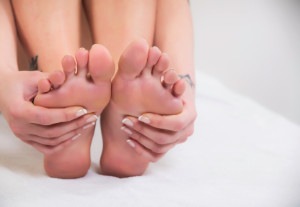 The term “shin splints” refers to pain along the shin bone in the lower leg that is caused by overuse. They are a common problem among athletes and people who regularly engage in activities, such as as running or jogging, that put stress on their lower limbs. Fortunately, pain from shin splints can be prevented and alleviated by stretching your legs. One simple stretch that you can do is toe curls. You can do this stretch by sitting on a chair with a towel spread out on the floor in front of you. Put your feet on the towel, and using just your toes, grab the towel and lift it up. Toe curls and many other stretches can improve the flexibility and strength of the muscles and tendons in the lower legs. If you suffer from shin splints and find that your pain is severe, chronic, or interferes with your daily activities, don’t hesitate to schedule an appointment with a podiatrist near you.
The term “shin splints” refers to pain along the shin bone in the lower leg that is caused by overuse. They are a common problem among athletes and people who regularly engage in activities, such as as running or jogging, that put stress on their lower limbs. Fortunately, pain from shin splints can be prevented and alleviated by stretching your legs. One simple stretch that you can do is toe curls. You can do this stretch by sitting on a chair with a towel spread out on the floor in front of you. Put your feet on the towel, and using just your toes, grab the towel and lift it up. Toe curls and many other stretches can improve the flexibility and strength of the muscles and tendons in the lower legs. If you suffer from shin splints and find that your pain is severe, chronic, or interferes with your daily activities, don’t hesitate to schedule an appointment with a podiatrist near you.
Exercising your feet regularly with the proper foot wear is a great way to prevent injuries and build strength. If you have any concerns about your feet, contact one of the chiropodists from The Footcare Centre. Our chiropodists can provide the care you need to keep you pain-free and on your feet.
Exercise for Your Feet
Exercise for your feet can help you gain strength, mobility and flexibility in your feet. They say that strengthening your feet can be just as rewarding as strengthening another part of the body. Your feet are very important, and we often forget about them in our daily tasks. But it is because of our feet that are we able to get going and do what we need to. For those of us fortunate enough to not have any foot problems, it is an important gesture to take care of them to ensure good health in the long run.
Some foot health exercises can include ankle pumps, tip-toeing, toe rises, lifting off the floor doing reps and sets, and flexing the toes. It is best to speak with Our chiropodists to determine an appropriate regimen for your needs. Everyone’s needs and bodies are different, and the activities required to maintain strength in the feet vary from individual to individual.
Once you get into a routine of doing regular exercise, you may notice a difference in your feet and how strong they may become.
If you have any questions please feel free to contact our office located in Niagara Falls, ON . We offer the newest diagnostic and treatment technologies for all your foot and ankle needs.
Exercise for Your Feet
Whether your feet are over-worked or under-worked, chances are they could benefit from some special attention. Even those who exercise regularly probably do not spend any time strengthening their feet. This can be just as rewarding as strengthening the rest of the body, since the health of your feet affects the health of the rest of the body as well, especially the ankles, legs, and spine.
For those who might not have any idea on how a foot-specific exercise might be conducted, there are several workouts that are fairly easy to perform in the comfort of ones’ home. One of the easiest is the toe rise, also known as the tip-toe. This exercise involves standing on the tip-toes for a count of 15 then resting the feet on the ground. This process should be repeated a minimum of three times a day in order to strengthen the feet.
Toe pick-ups strengthen the feet by working them in a very different way. In this exercise, small items are picked up using the toes in order to strengthen the muscles on the upper part of the feet. Once again three sets should be performed, with the item in question being held for 15 seconds then dropped. Items that may be picked up using the feet include marbles and even stationery, which works wonders for the toes and the surrounding muscles.
Yet another simple workout is the ankle pump. This can be done either upwards or downwards, but for the workout to be most effective both can be incorporated into the routine. As the term suggests, this involves lifting the foot off the floor and flexing the toes either towards the shin or towards the ground. This movement puts the feet and ankles through a large range of motion which works the muscles.
Last but not least, feet should be stretched so that the muscles can relax and recuperate. This can be done by placing both feet off of the floor and bracing oneself against the wall at a 45 degree angle. This ensures that the feet and ankles are adequately stretched once the workout is complete.
In short, giving the feet a good workout every now and then is important in order to avoid problems such as plantar fasciitis. It’s also important to warm-up or cool-down after running or vigorous walking. Foot exercises may be followed by a good foot massage. This encourages circulation in the feet as well as muscle relaxation.
What Are the Affects Cracked Heels Have on the Skin?
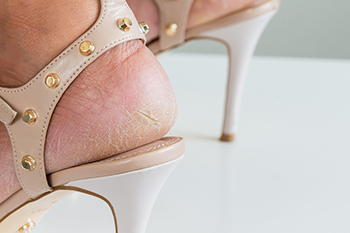 There are two layers of skin that are called the dermis and epidermis. The latter is the outermost layer, and is where cracked skin often develops. Heel fissures is the medical name for cracked heels, which can come from standing on hard surfaces for the majority of the day. Additionally, wearing shoes that do not fit correctly may cause this condition to occur, and this can include wearing shoes that have an open back. There are medical conditions that may lead to cracked heels, such as diabetes, psoriasis and eczema. Patients have found mild relief when the feet are washed and thoroughly dried, followed by applying a good moisturizer to them. If you have cracked heels, it is suggested that you consult with a podiatrist who can effectively treat this ailment, and advise you on proper foot care techniques.
There are two layers of skin that are called the dermis and epidermis. The latter is the outermost layer, and is where cracked skin often develops. Heel fissures is the medical name for cracked heels, which can come from standing on hard surfaces for the majority of the day. Additionally, wearing shoes that do not fit correctly may cause this condition to occur, and this can include wearing shoes that have an open back. There are medical conditions that may lead to cracked heels, such as diabetes, psoriasis and eczema. Patients have found mild relief when the feet are washed and thoroughly dried, followed by applying a good moisturizer to them. If you have cracked heels, it is suggested that you consult with a podiatrist who can effectively treat this ailment, and advise you on proper foot care techniques.
Cracked heels are unsightly and can cause further damage to your shoes and feet. If you have any concerns, contact one of the chiropodists from The Footcare Centre. Our chiropodists can provide the care you need to keep you pain-free and on your feet.
Cracked Heels
Cracked heels appear unappealing and can make it harder for you walk around in sandals. Aside from looking unpleasant, cracked heels can also tear stockings, socks, and wear out your shoes. There are several methods to help restore a cracked heel and prevent further damage.
How Do You Get Them?
Dry skin is the number one culprit in creating cracked heels. Many athletes, walkers, joggers, and even swimmers suffer from cracked heels. Age and skin oil production play a role to getting cracked heels as well.
Promote Healing
Over the counter medicines can help, especially for those that need instant relief or who suffer from chronic dry feet.
Wear Socks – Wearing socks with medicated creams helps lock in moisture.
Moisturizers – Applying both day and night will help alleviate dryness which causes cracking.
Pumice Stones – These exfoliate and remove dead skin, which allows for smoother moisturizer application and better absorption into the skin.
Change in Diet
Eating healthy with a well-balanced diet will give the skin a fresh and radiant look. Your body responds to the kinds of food you ingest. Omega-3 fatty acids and zinc supplements can also revitalize skin tissue.
Most importantly, seek professional help if unsure how to proceed in treating cracked heels. A podiatrist will help you with any questions or information needed.
If you have any questions, please feel free to contact our office located in Niagara Falls, ON . We offer the newest diagnostic and treatment technologies for all your foot care needs.
Solutions for Cracked Heels
Cracked heels can make life very frustrating and embarrassing when displaying the bare feet. Aside from being unpleasing to the eye, they can also tear stockings and socks and wear out shoes at a faster rate. When severe, cracked heels may cause pain or infection.
Cracked heels are a problem for those who are athletic, those who may walk a lot, and those who have especially dry skin. Those who use medication that dry the skin, those who swim often, wearing certain types of shoes, and those who are diabetic may have trouble with cracked heels. Seniors whose skin produces less oil may also have trouble with cracked feet. There is no one way to develop cracked feet, and there is no cure.
Today, the market consists of numerous products that have a variety of ingredients to promote healing. Some of these are over-the-counter. Others are prescribed by a doctor, especially for those who have chronic dry feet and heels.
Some doctors recommend wearing socks at night for those with rough skin. This helps further healing, and helps creams stay on longer and better absorb into the skin.
One way to alleviate dryness that causes cracked heels is by using moisturizers both day and night. Another way is to make sure the skin is clean and dry at all times. Using a pumice stone to buff away dead skin before putting on moisturizer can also help. Cracked heels will not respond to the cream unless the outer layer of skin is first removed through exfoliation. After exfoliation, lotion or ointment will be absorbed by the skin more easily.
Foods that produce healing and balance can also help the skin from within. Everything that is put into the body can either help it or hurt it. Taking supplements of omega-3 fatty acids and zinc can also be very beneficial.
Nevertheless, not all products are guaranteed to help treat cracked feet. Seeing a professional is best if other treatments options were unsuccessful. A podiatrist should be able to give the best advice to help with this problem.
What Are Hammertoes?
Hammertoes are a common deformity in which the second, third, fourth, or fifth toes bend downward at the middle joint. This gives the affected toes a hammer-like appearance. They may also be referred to as claw toes, mallet toes, or retracted toes. This deformity is said to be more common among people who have bunions or high arches. Wearing poorly-fitted shoes and socks that squish the toes together can exacerbate the problem as well. Hammertoes can be stiff and painful. Over time, the toe joints can lose their flexibility and you may be unable to straighten the toes without surgical intervention. People with hammertoes also often notice corns and calluses forming at the tops of their toes, where the skin over the bent toes rubs against shoes. If you are suffering from hammertoes it is suggested that you seek the care of a podiatrist.
Hammertoe
Hammertoes can be a painful condition to live with. For more information, contact one of the chiropodists from The Footcare Centre. Our chiropodists will answer any of your foot- and ankle-related questions.
Hammertoe is a foot deformity that affects the joints of the second, third, fourth, or fifth toes of your feet. It is a painful foot condition in which these toes curl and arch up, which can often lead to pain when wearing footwear.
Symptoms
- Pain in the affected toes
- Development of corns or calluses due to friction
- Inflammation
- Redness
- Contracture of the toes
Causes
Genetics – People who are genetically predisposed to hammertoe are often more susceptible
Arthritis – Because arthritis affects the joints in your toes, further deformities stemming from arthritis can occur
Trauma – Direct trauma to the toes could potentially lead to hammertoe
Ill-fitting shoes – Undue pressure on the front of the toes from ill-fitting shoes can potentially lead to the development of hammertoe
Treatment
Orthotics – Custom made inserts can be used to help relieve pressure placed on the toes and therefore relieve some of the pain associated with it
Medications – Oral medications such as anti-inflammatories or NSAIDs could be used to treat the pain and inflammation hammertoes causes. Injections of corticosteroids are also sometimes used
Surgery – In more severe cases where the hammertoes have become more rigid, foot surgery is a potential option
If you have any questions please contact our office located in Niagara Falls, ON . We offer the newest diagnostic and treatment technologies for all your foot and ankle needs.
